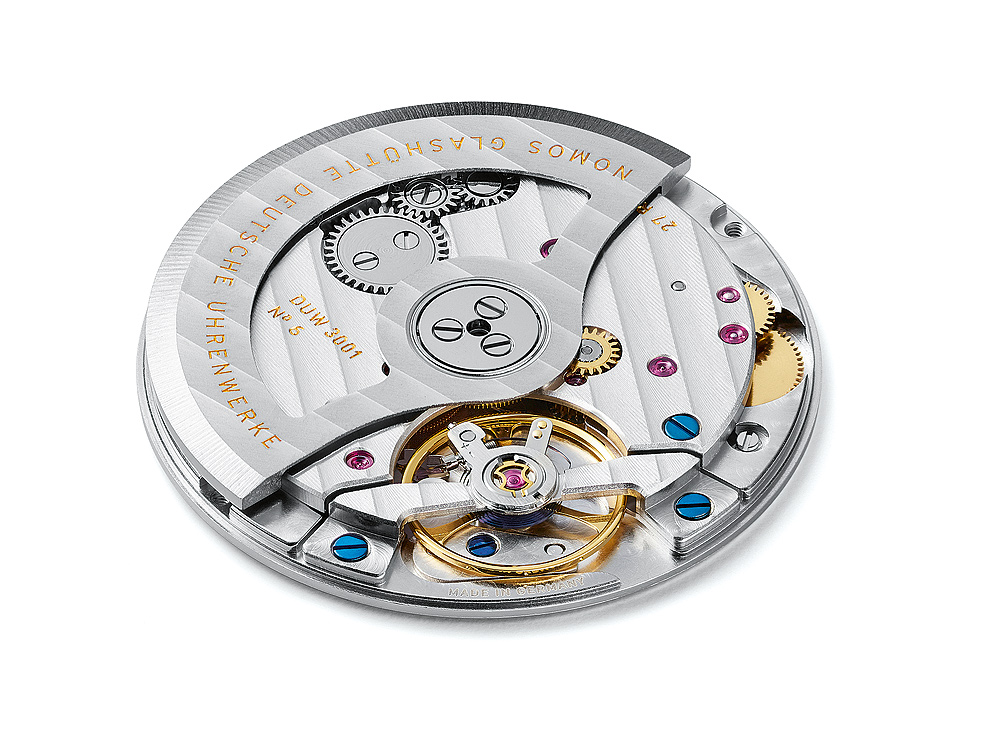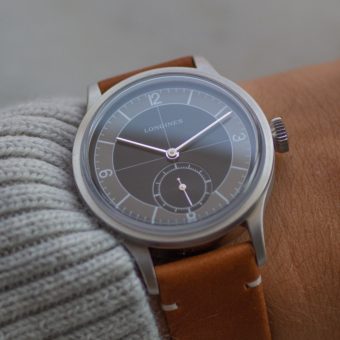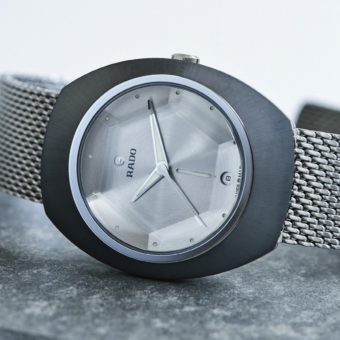In this feature from the WatchTime archives, we examine the 2016 released Neomatik version of Nomos Glashütte’s familiar Tangente watch, which was outfitted for the first time that year with an automatic in-house movement.
We’ve known Nomos Glashütte’s Tangente watch since its introduction in 1992, so the last thing we expected was a profound change. But in 2016 Nomos gave the watch a new automatic in-house movement and added it to its Neomatik collection.

This version of the Nomos Tangente is striking for several reasons. The Glashütte-based manufacture worked for many years to gain independence from Swiss movement suppliers: first with individual components, then with its own escapement subassembly (which it calls the “swing system”), and 2016 with the automatic Caliber DUW 3001, a newly developed automatic movement that ticks inside the Tangente Neomatik and other Nomos models. “DUW” stands for “Deutsche Uhrenwerke” (German watch movements) and refers to Nomos’s distinction as the maker of its own movements.
All About the Caliber DUW 3001
With an overall height of just 3.2 mm, Nomos’s 10th movement is only 0.3 mm thicker than its hand-wound counterpart, so it can fit inside the case of the original Tangente. Although the latest Tangente is equipped with the new automatic in-house movement, it remains within the brand’s price range of $1,500 to $6,000* for stainless-steel models: the familiar hand-wound version costs $1,900* with a steel caseback and $2,180* with a sapphire back; the automatic Tangomat sells for $3,280* and the Tangente Neomatik is priced at $3,460*.


Nomos was able to keep the price low for two reasons: extensive research and calculations, partly in collaboration with the Technical University of Dresden, allowed the new movement to be serially manufactured, and the company introduced ultramodern manufacturing and assembly techniques, which made it possible to increase production volume.
These goals were presented at the outset to the engineering team, so details relating to fabrication, assembly and servicing influenced the developmental work from the very beginning. One of the results: Caliber DUW 3001 is assembled in only three steps, compared to the five needed for previous Nomos calibers. “Now that we’ve fully mastered building movements, we can question everything,” says chief design engineer Mirko Heyne.
Theodor Prenzel, the design engineer behind the DUW 3001, says, “That’s why nothing other than a totally new approach was even considered for our new caliber. We changed many details in the classical construction and ultimately arrived at a totally new movement.”


The movement developers first turned their attention to the gear train. Although its construction had already been recalculated in collaboration with the Technical University of Dresden in 2009, the technicians subjected it to renewed scrutiny and customized it expressly for this caliber. By altering the number, arrangement and angles of the teeth, the specialists were able to boost the gear train’s efficiency by 10 percent to an impressive 94.2 percent.
That’s an enormous improvement in itself, but it’s all the more impressive when you consider that the usual tolerances had to be halved for this ultra-slim movement, which provides only 1 mm of height between the base plate and the three-quarter plate to accommodate the rotating components.
That’s under the Three-Quarter Plate …
According to Glashütte tradition, watchmakers try to put as many of the watch’s mechanisms as possible under the three-quarter plate. Nomos took this effort one step farther. Glashütte’s characteristically spacious bridge doesn’t cover just the gear train: the ratchet wheel, which is now only half as tall as its predecessor, also disappears under the three-quarter plate, as does the double click wheel for the automatic winding mechanism. Strictly speaking, the double click wheel is an entire subassembly, which transforms the bidirectional motions of the rotor into unidirectional action to tighten the mainspring. This extremely efficient mechanism works with a reverse angle of merely 10 degrees. For comparison, the corresponding angle is 27 degrees in the ETA 2824 and 42 degrees in Rolex Caliber 3135. Reducing the angle to 10 degrees means that overall, less power is needed to wind the DUW 3001.


The developers even used a new material for the ratchet wheel. They chose a substance that is easy to process and hardens readily, loses less mass due to abrasion, and runs with nearly no axial eccentricity. To create space for the automatic winding mechanism, Nomos’s own balance and its blued Carl Haas balance spring oscillate underneath a bridge. This also provides greater stability and thus more precise running.
But the rate’s accuracy is due primarily to the newly calculated flow of force. The power begins to flow from the low-rise barrel, which necessarily contains a narrower mainspring. This spring contains less material, so it exerts less pulling force. Despite less energy flowing from the barrel, where the moment of torque is just 670 gmm (compared to 800 gmm in the Rolex Caliber 3135 and 1,200 gmm in the ETA 2824), the optimized gear train ensures that the same amount of energy arrives at the swing system. Our tests confirmed good rate values and satisfactory amplitudes in various positions.

Another precise calculation was made between the automatic rotor and the barrel or, strictly speaking, the mainspring. As the mainspring becomes more tightly wound, the rotor moves more sluggishly, until the opposing force from the mainspring stops the rotor’s motions completely. This “rotor brake” reduces wear and lets the watch run with less noise because it prevents the rotor from continuing to turn unnecessarily after the mainspring has been fully wound.
Looking Through the Sapphire Caseback
Newton’s law of action and reaction seldom seems simpler or more extraordinary than when you view its consequences through the Tangente Neomatik’s sapphire caseback. You will be surprised that the rotor appears motionless and cast perplexed looks at the technology. Furthermore, you will see the handsome accents of Glashütte’s watchmaking tradition: striped patterns on the bridges and the rotor, Nomos’s circular graining on the base plate, blued screws and, if you look very closely, a blued balance spring. Another technical tidbit awaits discovery as well: the upper surface of the subassembly that conveys kinetic energy from the rotor, regardless of its direction of rotation, to automatically wind the mainspring. The three-quarter plate is engraved with the serial number of the movement. A second engraving along the narrow edge of the caseback states that our tested watch belongs to the “1st edition.” In accordance with the DUW’s numbering system, this first series contains 3,001 calibers in 10 different models: two versions each for the Tangente Neomatik, the Ludwig, the Metro, the Orion and the Minimatik.

The Tangente’s bipartite case is unchanged in nearly all other aspects: it remains a shiny, 6.9-mm-high, straight-sided cylinder with a very narrow bezel, distinctive angled lugs, a sapphire crystal above the dial, a sapphire window in the caseback and water resistance to 30 meters.
Last but not least: The Appearance of the Nomos Glashütte Tangente Neomatik
Our tested watch is attached, as usual, to an eye-appealing Horween Genuine Shell Cordovan strap, although a vegetal-tanned cowhide strap is also available for the Champagne version. The hand-sewn, remborded, cowhide strap is a bit stiff, so the 35-mm Tangente fits somewhat clumsily at first, but this situation soon improves. The pin buckle works well. The buckle’s closed frame eliminates the need for two belt loops on the leather strap. From day one, we found it unexpectedly smooth and easy to slip the end of the strap through the buckle.

Details on the Tangente’s dial assure that this watch looks like a Neomatik. Long, slender, black-anodized hands point to index strokes for the odd-numbered hours and to Arabic numerals for the even-numbered ones, except at 6, where the numeral is replaced by a sub-dial, decorated with concentric circles, for the seconds. An attention-getting red hand sweeps around this little disk, which is marked with three different types of index strokes and a quartet of Arabic numerals. The same red color is used on the dial for the name of this line of watches: “neomatik” is written in lower case, spelled with a final “k” and centered below the names “NOMOS” and “Glashütte,” located between the 11 and the 1. The numerals for the 5-minute markings along the dial’s edge are bright blue: we’re just sorry that the cyan paint doesn’t glow in the dark.

SPECS:
Manufacturer: Nomos Glashütte/SA Roland Schwertner KG, Ferdinand-Adolph-Lange-Platz 2, 01768 D-Glashütte, Germany
Reference number: 171
Functions: Hours, minutes, small seconds
Movement: In-house Caliber DUW 3001, automatic, 21,600 vph, Nomos swing system balance, Incabloc shock absorption, 42-hour power reserve, diameter = 28.8 mm, height = 3.2 mm
Case: Stainless steel, sapphire crystal, sapphire window in caseback, water-resistant to 30 m
Strap and clasp: Horween Genuine Shell Cordovan strap with stainless-steel pin buckle
Rate results (Deviations in seconds per 24 hours, fully wound/after 24 hours):
Dial up +0.2 / +6.0
Dial down +1.0 / +3.5
Crown up +0.7 / +3.0
Crown down -1.3 / -3.5
Crown left -0.4 / +4.6
Greatest deviation of rate 2.3 / 9.5
Average deviation +0.0 / +2.7
Average amplitude:
Flat positions 306° / 268°
Hanging positions 270° / 230°
Dimensions: Diameter = 35.1 mm, height = 7.1 mm, weight = 44 g
Variations: Champagne version ($3,580)
Price: $3,460*
Original photos by OK-Photography.
* Prices are subject to change.







I have a Nomos Tangente Neomatik Silvercut 39 mm, and I love it and find your review to be very helpful. One issue, though, is the sound. The rotor makes an awful ball bearing grinding sound. I have examined several Neomatiks at a Nomos dealer and all the DUW 3001 movements sound this way. It must be one of the trade-offs for the thinness of the movement, but I find it unfortunate. I considered returning the watch because of it, but I decided the watch is too beautiful to part with. Still, this is a negative characteristic.